GLEE Campers Learn How Electrical Engineering Impacts Their Everyday Lives
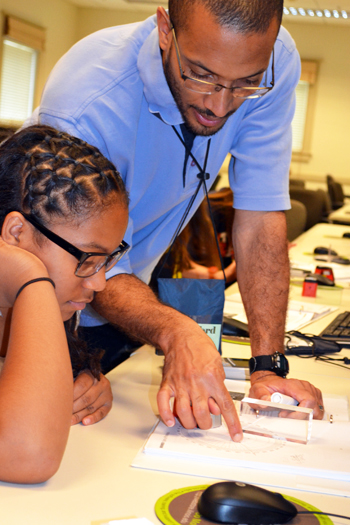
GLEE camp director, Lynford Goddard, instructs a camper during a session on optics.
September 19, 2013
During the GLEE (Girls Learning Electrical Engineering) G.A.M.E.S. camp this summer, July 15–19, fourteen high school girls learned a bit about electrical and computer engineering and got to practice what they learned during some hands-on projects working with circuits. The goal was to take something near and dear to the hearts of teenage girls—their cell phones—and help them understand some of the principles that make them work.
The brainchild of Electrical and Computer Engineering (ECE) professor and camp director Lynford Goddard, the 2013 GLEE camp was in its fourth year. The department received a start-up grant in 2009 from the Motorola Foundation, and the camp was first offered the summer of 2010. During the year interim, they set out to discover, "What are the typical ways to engage high school girls in Engineering?" then put together activities that are fun and interesting for girls.
Their initial idea for the camp was to talk about all of the electrical and computer engineering principles surrounding the use of a cell phone: for example, the way it does transmission of electromagnetic waves, signal processing, and image acquisition. However, according to Goddard, it turned out to be a bit ambitious to cram into one week.
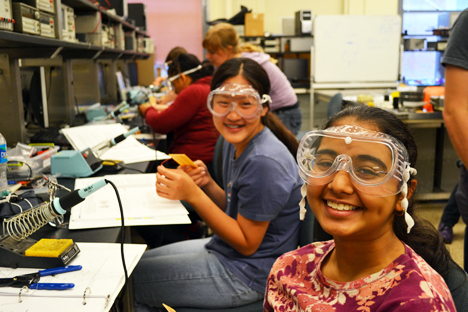
GLEE campers at a hands-on session during which they made circuits.
So they narrowed the curriculum down to a couple of projects. For one project, the girls put together an FM transmitter circuit, which they call a radio phone. In the circuit the girls build, they learn about how one's voice gets transmitted into a voltage signal, how it gets amplified, and then gets radiated through the antenna.
The second project: build an LED (light-emitting) calculator that can add numbers as high as 3 + 3…and display it with light.
In his fourth year running the camp, Goddard says he and the GLEE team have tweaked the original camp curriculum over the years; for instance, they eliminated some time at the computer to make room for additional hands-on activities. New for this year: instead of just suiting up and taking a tour of the clean room, once they were inside the girls did an activity fabricating their own solar cells using silicon wafers.

Lynfor Goddard explains the principles behind fiber optics.
When it comes to working with high school students, GLEE isn't Goddard's first experience; he's been doing it ever since he was in college, where he tutored high school students in physics, calculus, and statistics. Says Goddard: "I liked working with high school students, getting them excited about math and science. Being a professor, working with students is also one of the great joys of the job."
Although GLEE is a camp for girls, Goddard says his goal for outreach, per se, is to target not just female students, but to increase diversity in general in his field. "The programs that I'm involved in are focused on recruiting and retaining women in engineering; however, they also serve a little bit for working with students from under-represented minority groups. What I've seen in the camp so far, is that, typically, we'll get 25% to 30% of students who are African American, Hispanic. So it's a way to also work on ethnic diversity."
Why run a camp for a bunch of teenage girls? For one, Goddard just plain enjoys teaching students—of any age. "I think it's just fun. The whole reason that I'm in the academic field is to teach and to work with students, and to see them develop and see them learn. So this is just an extension of that to a younger age."
Another thing Goddard likes about GLEE: instead of just preaching to the choir, there's a whole crop of fresh new faces in the congregation.

GLEE camper at work soldering a circuit.
"It's an opportunity. It's a chance to inspire, to explain why the field is exciting, to explain what the challenges are. The opportunity to essentially interact with more people, rather than just kind of doing the same thing every day. It's fun. That's the best I can describe it."
But, unlike the semester-long courses Goddard teaches to his electrical engineering students, this is a one-week camp, so at least there are no tests to grade, right? "We do give a quiz at the end," Goddard sheepishly admits. "We're interested in learning how well the information is being received and what the girls remember from their experience."

GLEE camper holds a flashlight and curved glass tube which the instructors passed around so the campers could see how dielectric material can be used as a waveguide to direct light. The activity demonstrated how applications such as fiber optics work.
And are the girls understanding the material? Just like in the cartoons, where a light bulb appears over the head of a character in the animation, indicating he is having a bright idea, does Goddard ever see his campers suddenly "get it?"
"Definitely," acknowledges Goddard. "You can see it, especially when they're doing the circuit. Once you see them understand what certain parts of the circuit do, and they put it together, and they test it out—especially when it works, and they're able to find their transmission station…"
So what's the percentage of circuits that actually work? After all, these are high school girls, and it's a one-week camp. "I think all of them work," he indicates with satisfaction.
Goddard is quick to acknowledge that a lot of folks contribute each year to help make the camp a success. He expressed gratitude for his department and the 7 or 8 faculty members who helped teach lessons, Women in Engineering and the College of Engineering, who organized the camp and scheduled evening social events, as well as the initial financial support from Motorola. He was especially appreciative of the graduate students who helped, including Yemaya Bordain, a female graduate student who worked with GLEE camp this summer.
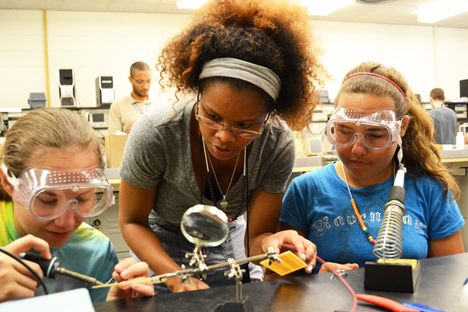
ECE grad student Yemaya Bordain (center) works with GLEE campers during a hands-on activity making circuits.
Bordain had a couple of reasons for taking a week away from her research to work with a bunch of high school girls. First, because she hopes to do outreach down the road, she wanted to see how it's done: "Indeed, this opportunity was a learning experience for me, since I want to lead similar programs in the future."
Her second reason? She'd like to help more female students, including students of color, to realize that not only is electrical engineering a great career, but they could be really, really good at it:
"I have always been a proponent for both outreach and expanding STEM to women and minorities. I considered this opportunity to facilitate GLEE camp a unique one in which I get to do two things that I already love to do. Young women very rarely get an opportunity to explore electrical engineering, since it is still a male-dominated field, and they don't see a place for them. I wanted to play an active role in showing girls that we not only have a place in this field—but we also kick butt in it."
What impact does she think her participation in the camp had on the girls? For one, she believes she served as a role model. "I think that having another woman in the room teaching showed the girls that they can all take my place one day."
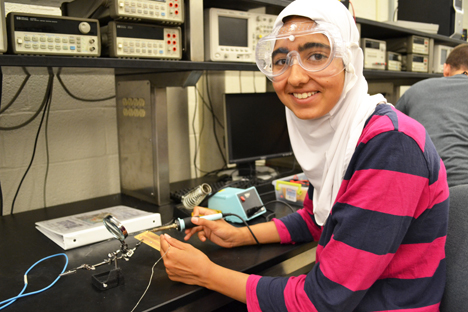
GLEE camper soldering the circuit she is making.
Here's another message she hopes her presence conveyed: Just because you're an electrical engineer it doesn't mean you have to stop being a girly girl: "It meant a lot that we could update each other on the latest celebrity gossip while handling a soldering iron and testing circuits with nails sporting trendy polish…They could see that being an electrical engineer doesn't mean that we must sacrifice our femininity."
And finally, she hopes she conveyed that engineers can still have fun.
"I think that they also appreciated that we could all be tech-geeks during week but still do the "wobble," a popular line dance, on Friday evening at the party. They learned that girls can be darn-good electrical engineers and still have real fun."
Does Bordain think any of the girls she worked with will end up in STEM careers or electrical engineering? She says yes to both.
"I know for sure that at least five of them will become electrical engineers. They were extremely enthusiastic about the work, despite it being quite challenging at times. I believe that most of them will end up in STEM."
Story by Elizabeth Innes, Communications Specialist, I-STEM Education Initiative.
Photos by Elizabeth Innes and Sneha Shruti, I-STEM Journalism Intern.
More: 8-12 Outreach, GAMES, GLEE, Electrical and Computer Engineering, Summer Camp, Women in STEM, 2013
For additional I-STEM articles about 2013 G.A.M.E.S. camp, see:
- 2013 G.A.M.E.S. Camp Gives Girls a Taste of Engineering—and College Life
- G.A.M.E.S. Camp Seeks to Navigate Girls into Aerospace Engineering
- G.A.M.E.S. Campers Experience Bioengineering—and Have Fun
- Environmental Engineering G.A.M.E.S. Camp Encourages Girls to Think/Design Green
- G-BAM Sends Campers This Message: Girls Make Awesome Engineers
- GLAM Seeks to Capture Girls' Imagination About Materials
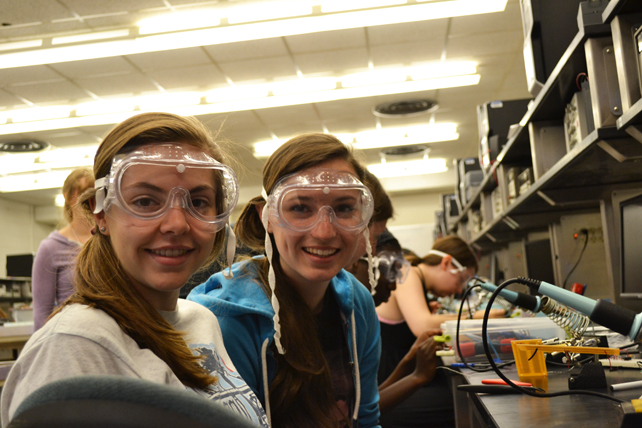
GLEE campers take a break during a hands-on activity making circuits.













.jpg)
















